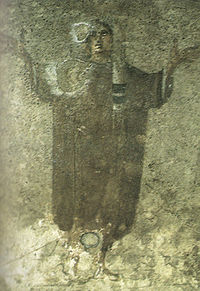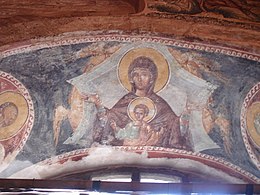Our Lady of the Sign
The icon of the Blacherniotissa Mother of God of the Sign ( Russian Знамение (znamesie), Greek Πλατυτέρα (Platytera)) is in the Byzantine iconography , later later in the Russian, a certain type of an image of Mary and is based on three images of grace in the Blachernenkirche in the Blachernenkirche back in Constantinople . ( See: Maria orans )
The name
The Greek name Platytera (Greek: platys = wide, wide) is taken from a troparion , with which Mary is praised in Basil's anaphora : "He made your body larger than the heavens" (her body is wider than the sky, there she carried Christ), therefore she is also called Platytera ton Ouranon (Greek: "which is more comprehensive than heaven").
iconography
The icon embodies the prophecy of Isaiah 7:14: "The Lord himself will give you a sign: Behold, a virgin is pregnant and will give birth to a son, her name will be Immanuel ." Mary is the sign that God gives to mankind, to bring hope and salvation to the world. Mary is “Our Lady of the Sign”, who conceives and gives birth to the Son, who is expected by humanity, so that he may bring salvation to all peoples.
The Mother of God of the Sign stands frontally with her arms raised to the sides in an oranten pose , her eyes directed towards the observer. Maria's sweet and wistful expression is typical of Byzantine icons . She wears a cloak over her robe on which three stars can be seen, which remind the holy virginity of the Blessed Mother. Her feet rest on a red carpet to show off her regal demeanor.
A medallion ( clipeus ), symbol of heaven, with the unborn clothed baby Jesus hovers in front of her breast (according to Isaiah 7:11: “the virgin will conceive a womb and give birth to a son)”. The baby Jesus has the face of an adult in miniature and his arms are open in the sign of appreciation for humanity as he blesses with both hands.
If Mary is depicted as a half-length figure, the Christ Child appears without the Clipeus framing it.
Marian miracle
Our Lady of the Sign, or her banner, which the Byzantine emperors wore at the head in battle, is said to have saved Constantinople in the sieges of 626 and 860 . 1170 is said to have saved Novgorod , one of the oldest and most important cities in Russia, from the attack of the Suzdals . In 1532 Our Lady is said to have saved Novgorod from the plague.
The spread of the icon

Our Lady of the Sign found particular veneration in the Russian Church . Byzantine missionaries brought her to Russia , where she was kept and venerated in the Transfiguration Church on Ilyina Street in Novgorod . The icon of Our Lady of the Sign became famous in 1170 when Novgorod was liberated through her intercession.
![]()
In February 1170 the troops of the Grand Duke of Suzdal , Andrei Bogolyubsky , invaded the city of Novgorod. After three days of siege, the citizens of Novgorod were exhausted from the bloody fighting and were convinced that only the Blessed Mother could help them. Johann , the archbishop at the time, prayed in front of the icon on the third night of the war and asked the Mother of God for help when he clearly heard a voice whispering to him to bring the icon onto the city wall so that it could be removed from the enemies who themselves Were Christians , could be seen and would accept the gesture as a peace sign.
After the Divine Liturgy , the Virgin was brought to the city wall in procession to the sobbing of the faithful and shown to the enemies who fired a rain of arrows at the crowd. One of these arrows hit the icon of the Blessed Mother in the face, who miraculously began to cry. The bishop spoke of miracles. The sign from heaven had come. A cloud covered the besiegers who understood the profane gesture. An internal struggle ensued which destroyed the unholy troops. The citizens of Novgorod seized the opportunity to launch the decisive attack. The enemy was defeated. The icon's reputation spread throughout Russia and soon crossed Russian borders. Many of them are copies of the sacred image and all of them tell of miracles.
In 1352 Novgorod was struck by the plague, the disappearance of which was attributed to Our Lady of the sign. The grateful residents built a new stone church for her in 1354, where she was transferred in 1536 and remained as Ivan III until 1478 . besieged the city.
In 1682 the Cathedral of Our Lady of the Sign was built on the site of a burnt down church, called the Church of Our Lady of the Sign , where the icon of Our Lady of the Sign got a new home. During the Soviet period it was housed in the nearby museum. In the 1990s, the icon came to the St. Sophia Cathedral , where it is still located today.
Our Lady of the Sign, Tretyakov Gallery , 13th century
Our Lady of the Sign, Cathedral of the Dormition in Moscow
Our Lady of the Sign with Silver Riza in the State Historical Museum in Moscow, 18th century
Our Lady of the Sign in the Greco-Byzantine pilgrimage church of SS. Cosma e Damiano in San Cosmo Albanese , Calabria , 20th century
Our Lady of the Sign in the Greco-Byzantine parish church of San Mauro in Cantinella ( Corigliano Calabro ), 20th century
See also
literature
- Lorenzo Ceolin: L'iconografia dell'immagine della madonna . Storia e Letteratura, Rome 2005, ISBN 88-8498-155-7 , p. 40 (Italian, online version (preview) in Google Book search).
- Adolf Weis: The Madonna Platytera, draft for a Christianity as a visual revelation based on the story of a Madonna theme . Langewiesche publishing house , Königstein i. Ts. 1985, ISBN 3-7845-8360-1 .
Web links
- Platytera. In: Beyars.com. Retrieved September 13, 2017 .
- Platytera. In: Wissen.de. Retrieved August 13, 2017 .
Individual evidence
- ^ Translation: Sergius Heitz , Mysterium der Adoration . ISBN 3-922727-23-9 . P. 431.
- ^ Gabriele von Horn: New dictionary for icon art . novum pro, 2010, ISBN 978-3-99003-212-1 , p. 65 ( online version (preview) in Google Book search).
- ^ A b Heinrich Schmidt, Margarethe Schmidt: The forgotten pictorial language of Christian art: a guide to understanding . CH Beck, Munich 2007, ISBN 978-3-406-54768-3 , pp. 204 ( online version (preview) in Google Book Search).
- ↑ a b La Vergine del Segno. (PDF) In: Santipietroepaolo.net. P. 1 , accessed August 15, 2017 (Italian).
- ↑ a b L'Icona della Vergine orante (del segno). In: Reginamundi.info. Retrieved August 15, 2017 (Italian).
- ^ A. Gentili: Maria e la fine dei tempi. Approccio biblico patristico e storico . Città Nuova, Rome 1994, ISBN 978-88-311-3227-5 , p. 119 (Italian, online version (preview) in Google Book search).
- ↑ a b Lorenzo Ceolin, p. 85
- ↑ Lorenzo Ceolin, p. 86
- ↑ L'icona della Madre di Dio del Segno. In: Santuarimariani.org. Retrieved August 18, 2017 (Italian).
- ^ Cathedral of Our Lady of the Sign. In: visitnovgorod.com. Retrieved August 18, 2017 .










